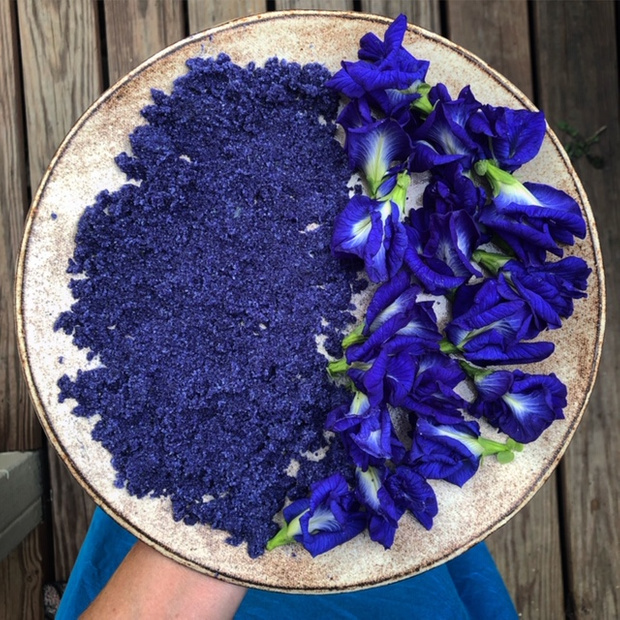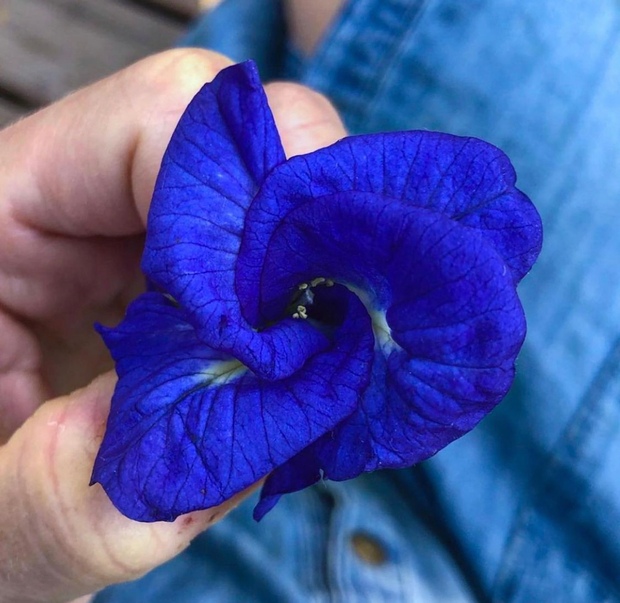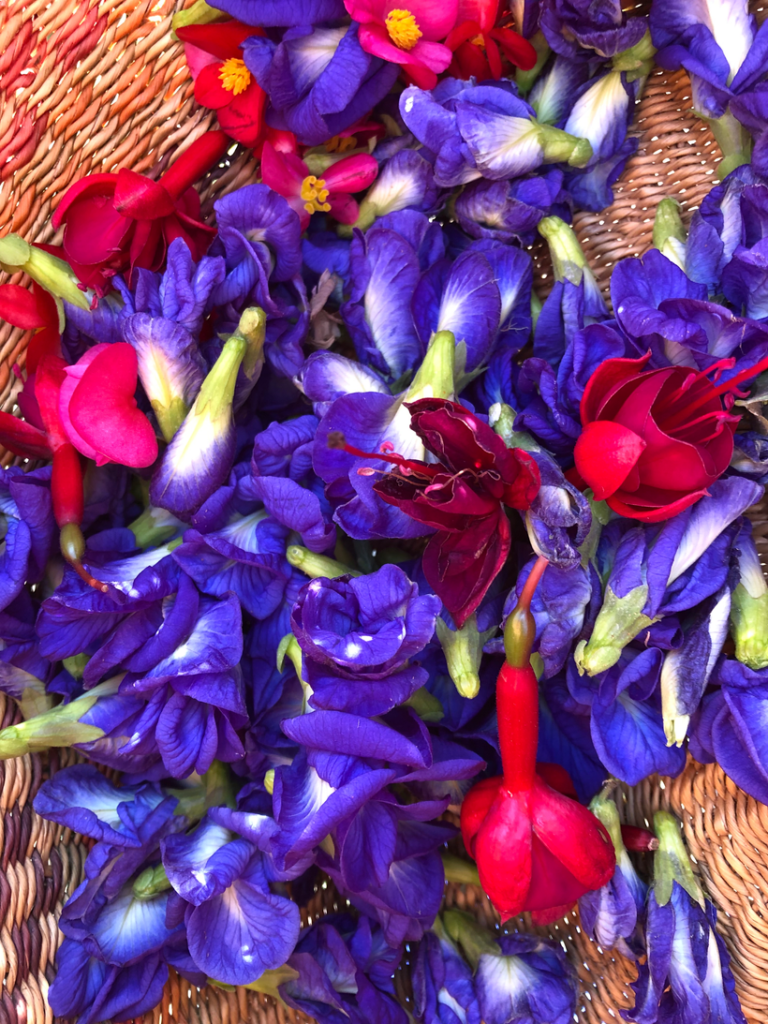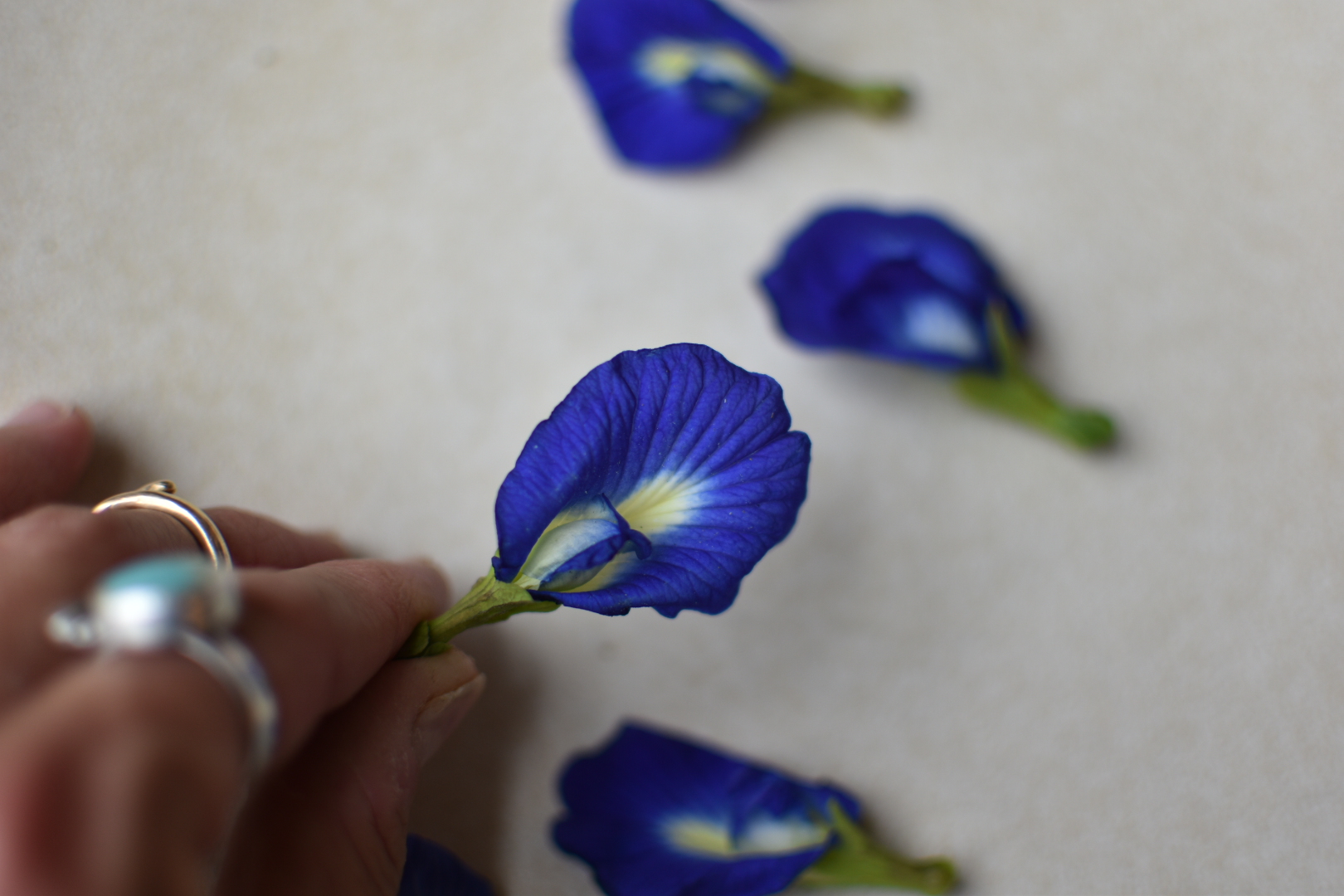Butterfly pea flower, Clitoria ternetea, is a plant that has been used medicinally for hundreds of thousands of years in Ayurvedic, Chinese, and Thai Traditional Medicine. It is currently being studied for the multitude of healing benefits that is has, including its potential to stop the growth of cancer cells and inhibit HIV.
I use this prolific vining plant in many of my treats and savory meals, as well as in medicinal preparations. They are beloved for their color magic and medicine, and we will go over how to grow and process them for almost anywhere in the world.
Butterfly pea flowers are endemic to tropical areas, and they will definitely grow best there, but they can be grown all over the world. I live in Colorado at a relatively high altitude and my growing season is very short with deep frosts and snow possible in the months of May and September. I also grew this beautiful plant in New Mexico at an even higher altitude. It requires a slightly different approach, but they bloom prolifically once they are growing.
I met this plant many years ago while working on a farm in Hawai’i. A Hawaiian indigenous medicine man offered me a cup of tea made with the blooms. I was completely floored by the color and the gentle, yet powerful medicine this plant carries. He gave me an 8 oz bag of the dried flowers, and I began creating with them. I fell in love with this plant and began growing it the following season, learning from it directly and beginning to incorporate it into more and more recipes. The flowers impart a beautiful blue color to foods and drinks that turns pink/purple with the addition of an acid, such as lemon juice.

Many years ago, I dreamed of growing a farm wholly dedicated to blue and purple-hued plants. Although that was not the route we took with the farm, my fascination and love grew for these anthocyanin-rich plants that are often a rarity in the supermarket and grocery store.
In terms of color, blue is one of the rarest colors in nature for an edible food. Blueberries are the exception, and they are of course, excellent for your health. In a typical grocery store in the Western world, and/or in a typical North American diet, a large portion of the food is white, tan or brown in color. Blue and purple-colored foods are the least eaten foods.
There are receptors all over our bodies for various compounds, and in the past few years or so, there has been a lot of talk and studies around cannabinoid receptors in the body. These are specific receptors that were originally believed to be reserved for only endocannabinoids, compounds that come from the hemp/marijuana plant. However, new research continues to emerge all the time and there is evidence that nettles, tulsi and even anthocyanin-rich foods all plug into these same receptors in our system.
We have co-evolved with plants over time, and the fact that we have receptors built into our physiological make-up for specific compounds that are only present in specific plants is so exciting.
Anthocyanins, the compounds that are responsible for the vibrant blue hue of these flowers, are a class of water-soluble flavonoids. Anthocyanins are bioactive compounds with incredible benefits including anti-inflammatory properties, antiviral properties, and preventing age-related chronic diseases (such as cancer, neurodegeneration, eye-related diseases, etc).

MEDICINE:
Butterfly pea flowers have been used in medicinal preparations for hundreds of thousands of years as aphrodisiacs, as adaptogens (both energizing and stress relieving), and for a variety of ailments, including as a hepatic (liver) & heart healer, and a libido enhancer.
In Ayurvedic medicine, butterfly pea flower is most often recognized for its brain benefits. It is a neuroprotective herb and can also be supportive for depression, anxiety, alzheimers and chronic health issues.
Butterfly pea flower is also said to be helpful in treating diabetes type 2, and is it is packed with antioxidants. The flower is antimicrobial and anti-inflammatory, and it is a mild analgesic, helping with chronic pain.
It is also said to help with reproductive issues, and regulating the menstrual cycle.
In addition, Butterfly Pea is one of the only species of plant to produce specific peptides called cyclotides. Studies are preliminary, however, evidence shows these cyclotides as being toxic to cancer cells, as well as exhibiting properties that fight against HIV, various forms of cancer, and other harmful diseases.
Allopathic medicine continues to verify and look for answers in the plant medicines that have been worked with for thousands of years by indigenous peoples.
Summer harvest of Butterfly Pea Flowers, Fuchsia & Begonias

GROWING:
Butterfly pea flowers will grow perennially in tropical areas like Thailand and Hawai’i, in zones 9-10, but will only grow annually in other zones, meaning that your plants will die at the end of the season, so you will want to save your seeds before the cold weather sets in where you live.
I have found butterfly pea flower seeds on Etsy and on Amazon. When I first started growing them, there were not a lot of seed companies that had the seeds, but I imagine there are many more now as it has become a hugely popular plant. I ordered from a few different places after the seeds didn’t germinate at first, and I also received seeds that were just regular peas. Now I save seeds and replant each year.
Butterfly pea flower grows relatively well in a variety of climates with a little help from you! If you have space outside with direct sunlight, or you have space in pots, you can grow them! They do love well-drained soil and steady waterings in the beginning, but they are actually relatively drought tolerant. They will start very slow if you are in a climate like mine which is cool at night even into the summer months. Suddenly they will begin producing loads of flowers, and you will need to keep harvesting to help them keep producing.
Once you have the seeds, you can decide on planting into (well-drained) pots, starting seeds in seedling trays or direct sowing. I always start my seeds ahead of time in an effort to get them very strong and healthy before setting them into the ground.
I have also started seeds by cutting the harder outer shell of the seed slightly with a knife and keeping the seeds in an open jar with a constantly dampened paper towel until they sprout. Then, transplanting them into a mixture of potting soil and compost in seedling trays. Once they are strong and have formed sprouts and leaves AND there’s no more danger of cold weather/frost, they can be transferred to a space outside.
When you transplant, pick a sunny place (or a pot that you can have in a sunny place), and dig a hole about twice as large as your transplant and set it inside. Pack soil the soil back in around the seedling. Make sure you dig a little hole big and deep enough for them to be sitting just below the soil line. This can help them stay moist when it gets hot and dry. If you are in a very dry area like me, you may want to mulch around your plants. Mulch can be things like wood chips or straw/hay that you set all around the plant in about a 3 inch thickness, which helps with weed pressure, and you won’t need to water as often!
Preferably, butterfly pea flower would have good drainage in the soil, compost mixed into the soil, and regular watering. This plant doesn’t want to be overwatered though! Butterfly pea flower is also often used as a soil amendment itself because it is a nitrogen-fixer, like other peas and legumes, and helps keep the soil healthy.
Where we rent land, we have hoop houses up which are very similar to greenhouses, but they are not heated and are far less expensive to build. Usually the butterfly pea flowers are planted in there because they like the heat, and our weather is extremely unpredictable. However, we have also planted them right outside next to the house and they have thrived without the cover of the hoophouse.
I have also seen people grow them very well in pots, using the same method described above, and just direct sowing them. Although these beautiful flowers look delicate, they are actually a fairly hardy plant that can grow tenaciously with just a little attention.
As Butterfly Pea Flowers are a vining plant, they will need a trellis, fence or stands to climb and wind around. They can grow to be 6-10 feet high (in more tropical climates) and will bush out about 2-3 feet at their largest. My plants are usually fairly short as they have a small season of growth here.
To care for them, you will want to clip any dead leaves or diseased-looking bits. If you want your flowers to keep producing you need to pick them regularly and before they form seed pods. To save seeds, let the pods grow out and get tan-brown before harvesting. At the end of the season, I also harvest the roots to use for medicinal purposes.
I recommend spending time with this plant in an intentional way, sitting with it and seeing what you feel when you make a tea or take a nibble of a single flower. This is an ancient medicine plant that has much to share with us.
PREPARATIONS:
Butterfly Pea Flowers can be preserved and used for medicine making and food. The primary way I preserve this plant is by drying the flowers. I collect the flowers every couple days and lay them out on a plate or screen to dry. While your flowers are drying, you will want to flip them over every 8 hours so they dry evenly. I wait several days to a week until they are completely dry before putting them into a sealed glass jar in a dark cabinet.
The dried flowers can then be used for teas and coloring for treats and savory meals. They can also be powdered in a spice grinder and used that way.
I also make alcohol tinctures with the flowers, using vodka so the color is retained in the alcohol. I save the roots, cleaning them and drying them for use in soups and alcohol tinctures. The roots are known to be particularly powerful for liver health.
- If you want to try Butterfly Pea Flowers, I recommend the brand Rishi — they carry organic flowers and teas and are also Fair Trade, from what I remember. I think there are lots of brands carrying them now, so they are pretty easy to find! I suggest trying them in the tea form first, and sitting with the tea to see how it feels in your system. If you want to get to know a plant, tea is an incredibly good place to start.

Comments:
share